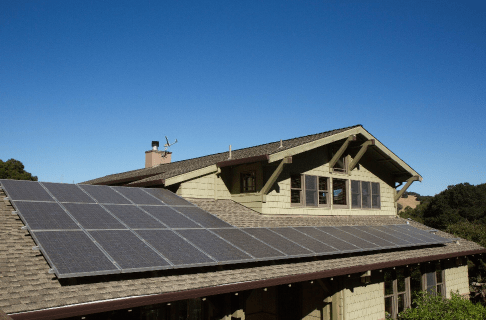
Consumer priorities continue to shift to sustainability. Solar power has gone from an environmentalist’s dream to the key to home energy efficiency.
Today, understanding the basics of solar energy is not just a matter of green ideology. It’s a key way to cut our carbon footprint and energy costs.
In this guide, we will show the path to energy optimization and using solar technology in your home. We will demystify the process for any homeowner eager to save energy.
Getting to Know Solar Basics
Before diving into sustainable energy solutions, first grasp the basic principles. Solar power harnesses the sun’s energy to create electricity. The ‘photovoltaic effect’ involves materials like silicon crystals. They release electrons when hit by photons.
Solar panels are key. They turn sunlight into electricity to power homes, store energy, or connect to the grid. Advancements make solar panels easier to install.
Inverters are vital in the solar equation. They convert panel-generated DC electricity to AC used in homes. Modern systems use ‘microinverters’ under each panel. They make energy production efficient and installations flexible.
The Economic Side of the Solar Spectrum
Solar power’s financial considerations can be complex. But, knowing the economic incentives can make the investment much more attractive.
The Art of Going Solar Without Breaking the Bank
The initial cost of solar installation may seem high. But, there are financial mechanisms that make it more attainable.
Government incentives, such as tax credits, rebates, and grants, can greatly cut the upfront cost. Additionally, solar financing options include leases or power purchase agreements (PPAs). They spread the cost over time, often with little or no money down.
Crunching the Numbers with Solar ROI
Solar panels are not just an environmental investment-they’re financial ones too. The ROI of solar comes from energy savings, incentives, and often added home value. Solar panels last 25-30 years. So, their long-term financial gain is a strong reason to install them.
Navigating Solar Incentives and Rebates
You must understand local, state, and federal solar incentives. This is critical to maximizing your solar savings.
These perks can cut the cost a lot. Some programs offer big rebates or credits. They pay you back for your energy production.
Solar for All Seasons: Weathering the Elements
One concern often raised about solar power is its reliance on sunshine. Indeed, clouds come and go and the sun is absent at night. This makes us think strategically about storing energy and integrating it into the grid.
Uninterrupted Solar Power with Batteries
The solution to variable sunlight is solar batteries. These devices store extra energy from your panels. They let you power your home at night or on overcast days.
Products like Tesla’s Powerwall or the Sunrun Brightbox have made energy storage a key companion to home solar.
Hybrid Systems and the Grid
Another avenue is hybrid solar systems, which combine the best of on-grid and off-grid reliability. These setups store energy with batteries.
They stay connected to the traditional grid, which provides consistent power. It also allows the possibility of selling extra energy back through net metering.
The Installation Process: From Sun to Socket
Installing solar panels is a multi-step process that involves more than putting up the panels themselves. It involves system design and mounting, as well as wiring and regulations. It’s a joint effort that demands precision and compliance.
Designing Your Solar System
Before any mounting or wiring takes place, the design phase is critical. Assessing your home’s structure, orientation, and energy needs will determine the size and layout of your solar system. Sophisticated software, along with professional consultation, helps in crafting the ideal setup.
Mounting Your Panels for Maximum Exposure
The placement of your solar panels is a critical determinant of their productivity. Factors such as the angle, shading, and elevation must be optimized to ensure the most efficient capture of sunlight. Experts, like this company specializing in solar energy from Blue Raven Solar, use their skills to adjust these variables. They also secure the panels for long-term performance.
Wiring Solar Arrays for Efficiency and Safety
Once the panels are secured, the next step is to connect them properly. Wiring a solar system is a balance of efficiency and safety.
It needs good insulation, grounding, and protection from the elements. This process ensures that the electricity flows smoothly and with minimal loss from panel to inverter.
The Environmental Dimension of Solar Adoption
Besides personal benefits, the environmental impact of home solar power is significant. Every kilowatt-hour from solar energy reduces reliance on fossil fuels, cutting greenhouse gas emissions.
Shifting to solar power means cleaner air, leading to healthier communities. A solar installation helps combat air pollution by replacing coal or natural gas for electricity generation. Many solar power users are driven by reducing their carbon footprint. A 6-kilowatt solar system can prevent over four metric tons of CO2 emissions annually, equal to planting 100 trees per year.
Adopting Solar Power as a Community
The spread of solar technology isn’t just about individual homes; it’s also about building a community dedicated to a sustainable home energy future. Solar cohousing involves multiple homes sharing a solar setup to save resources and space, boosting efficiency and cutting costs while strengthening the bonds of a sustainable neighborhood.
Neighborhoods can boost solar adoption through group purchasing or coordinating community solar farms, democratizing energy sustainability for a broader reach.
The Role of Education in Solar Transition
Education divides passive and proactive roles in the solar shift. Informed consumers can make decisions and advocate for sustainable energy policies.
The workshops and resources educate on solar energy topics. They empower people to switch to solar. Stay updated on solar power policies to support its growth. Engage in advocacy for wider access to this renewable resource.
Understand the Basics of Home Energy Optimization
Transitioning to solar power is a strategic move towards sustainability and financial savings. It involves understanding the basics of energy optimization. You must then evaluate the economic benefits and consider environmental impacts. Installation requires careful planning and execution.
With available incentives and the right technology, solar energy is accessible and beneficial. It’s a commitment to a cleaner, renewable future, aligning personal goals with global needs. Solar power empowers homeowners, and communities, and ultimately contributes to a healthier planet.



